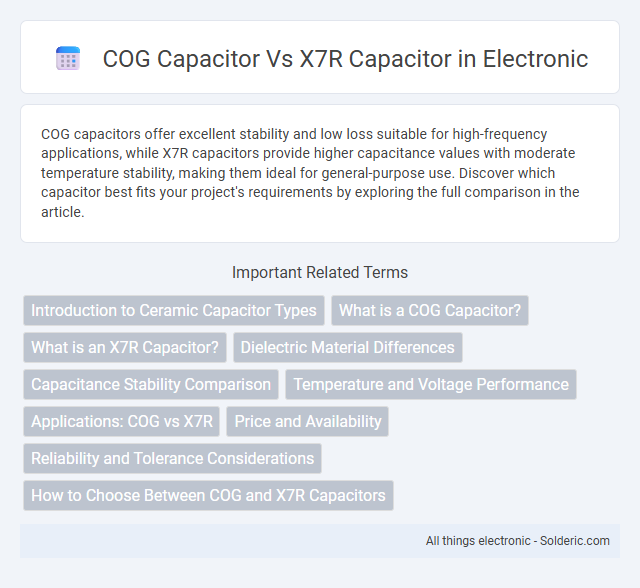COG capacitors offer excellent stability and low loss suitable for high-frequency applications, while X7R capacitors provide higher capacitance values with moderate temperature stability, making them ideal for general-purpose use. Discover which capacitor best fits your project's requirements by exploring the full comparison in the article.
Comparison Table
| Feature | COG Capacitor (NP0) | X7R Capacitor |
|---|---|---|
| Capacitance Stability | Excellent; near-zero temperature coefficient | Moderate; capacitance varies with temperature |
| Temperature Range | -55degC to +125degC | -55degC to +125degC |
| Dielectric Type | Ceramic, Class 1 | Ceramic, Class 2 |
| Dielectric Constant | Low (~30-40) | High (~2000-4000) |
| Capacitance Range | Small (pF up to nF) | Wide (nF to uF) |
| Voltage Rating | Up to 500V or higher | Usually up to 50V to 100V |
| Application | High precision, RF, timing circuits | General purpose, decoupling, filtering |
| Losses (Dissipation Factor) | Very low (0.001 or less) | Higher (0.02 to 0.05) |
| Cost | Higher | Lower |
Introduction to Ceramic Capacitor Types
COG capacitors, also known as NP0, exhibit excellent temperature stability with a near-zero temperature coefficient, making them ideal for precision circuits and timing applications. X7R capacitors offer higher capacitance values and are more cost-effective but have a wider temperature coefficient, which impacts performance in temperature-sensitive environments. Your choice depends on the balance between stability and capacitance required for your electronic designs.
What is a COG Capacitor?
A COG capacitor, also known as NP0, is a type of ceramic capacitor characterized by its exceptional stability and low loss, maintaining a negligible capacitance change of less than +-30 ppm/degC across a wide temperature range (-55degC to 125degC). It is primarily used in high-frequency and precision applications where capacitance stability and low dielectric absorption are crucial, such as RF circuits, filters, and timing devices. Compared to X7R capacitors, which offer higher capacitance but with significant variations over temperature and voltage, COG capacitors provide superior reliability and consistency.
What is an X7R Capacitor?
An X7R capacitor is a type of multilayer ceramic capacitor known for its stable performance at a wide temperature range, typically -55degC to 125degC. It offers a moderate dielectric constant, providing higher capacitance values in a smaller size compared to COG capacitors but with more pronounced capacitance variation under voltage and temperature changes. You should consider X7R capacitors when you need a balance between capacitance density and temperature stability in applications like decoupling and filtering.
Dielectric Material Differences
COG capacitors use a ceramic dielectric material known for its Class 1 characteristics, offering stability, low loss, and minimal capacitance variation over temperature and frequency changes. X7R capacitors utilize Class 2 dielectric materials, which provide higher capacitance per volume but exhibit greater variation in capacitance with temperature, voltage, and aging. The differing dielectric formulations impact the capacitor's performance in precision and filtering applications, with COG favored for stable, low-noise scenarios and X7R suited for applications requiring higher capacitance with moderate stability.
Capacitance Stability Comparison
COG capacitors, also known as NP0 capacitors, offer superior capacitance stability with minimal variation over temperature ranges from -55degC to 125degC, maintaining changes within +-30 ppm/degC. In contrast, X7R capacitors exhibit larger capacitance fluctuations, typically up to +-15% across a temperature range of -55degC to 125degC, impacting precision in sensitive circuits. Understanding these differences helps you select the right capacitor to ensure reliable performance in temperature-sensitive applications.
Temperature and Voltage Performance
COG capacitors exhibit excellent temperature stability with minimal capacitance change over a wide temperature range, typically from -55degC to +125degC, making them ideal for precision circuits. In contrast, X7R capacitors offer higher capacitance values but experience significant capacitance variation up to +-15% within -55degC to +125degC, affecting performance under temperature stress. Your choice between COG and X7R capacitors should consider the voltage rating and the required stability, as COG capacitors maintain capacitance better at higher voltages compared to X7R types.
Applications: COG vs X7R
COG capacitors offer exceptional stability and low loss, making them ideal for precision timing circuits, RF applications, and sensor interfaces where consistent capacitance is critical. X7R capacitors, with their higher capacitance density and moderate stability, are well-suited for general-purpose decoupling, power supply filtering, and bypassing in consumer electronics. The choice between COG and X7R hinges on balancing capacitance stability requirements against space constraints and cost in specific applications.
Price and Availability
COG capacitors generally cost more due to their superior stability and low loss characteristics compared to X7R capacitors, impacting your budget when high precision is essential. X7R capacitors are widely available and manufactured in large quantities, making them more affordable and easier to source for general applications. Your choice between COG and X7R capacitors should consider price sensitivity and availability based on the specific performance requirements of your project.
Reliability and Tolerance Considerations
COG capacitors offer superior reliability due to their stable temperature coefficient and low dielectric losses, making them ideal for precision applications requiring consistent performance. X7R capacitors, while providing higher capacitance in a smaller package, exhibit greater capacitance variation with temperature and voltage, leading to less predictable behavior. Your choice between COG and X7R capacitors should consider tolerance requirements and environmental stability to ensure optimal circuit performance.
How to Choose Between COG and X7R Capacitors
Choosing between COG and X7R capacitors depends on your circuit's temperature stability, capacitance range, and tolerance requirements. COG capacitors offer superior temperature stability (+-30 ppm/degC) and low dielectric loss, making them ideal for high-frequency and precision applications, while X7R capacitors provide higher capacitance values with moderate stability (+-15% over -55degC to +125degC) suitable for general-purpose decoupling and filtering. Your decision should balance the need for precision against available capacitance and cost constraints to optimize performance in electronic designs.
COG Capacitor vs X7R Capacitor Infographic

 solderic.com
solderic.com